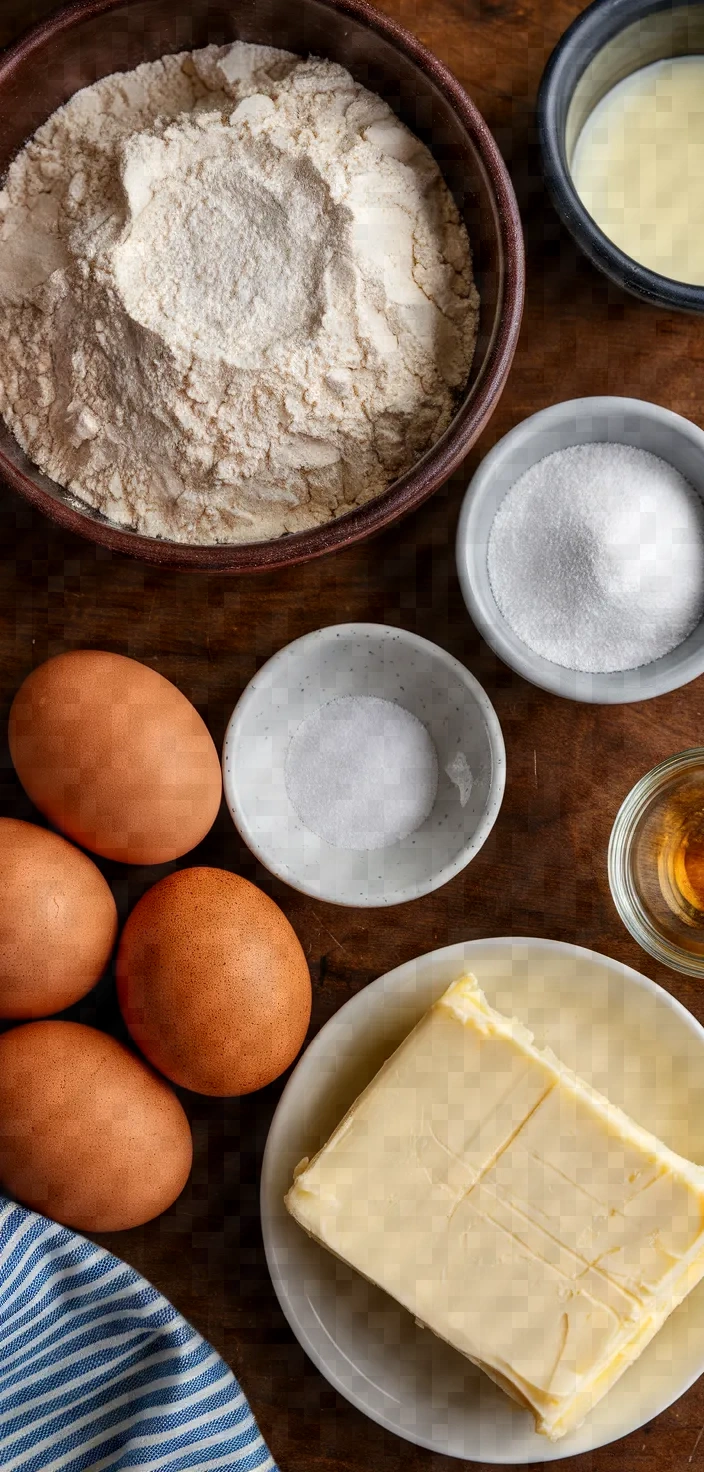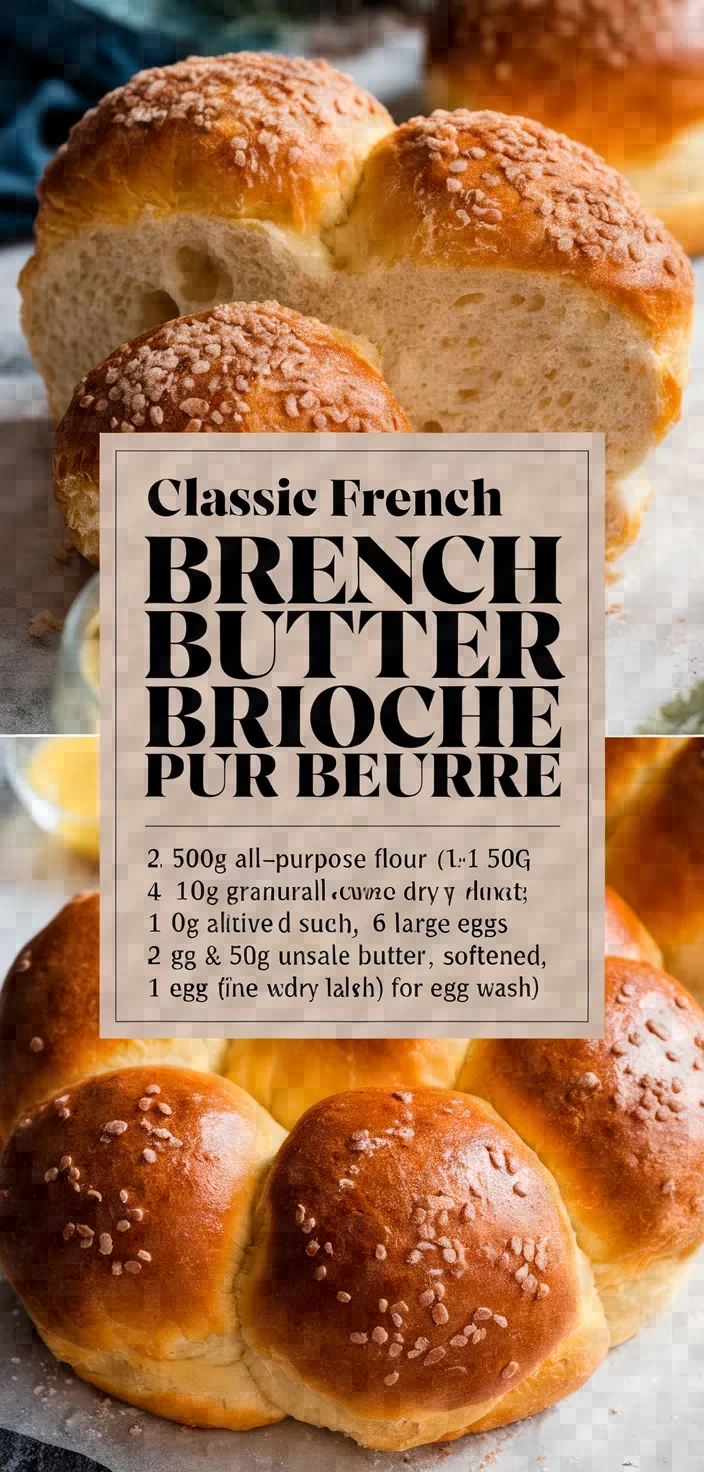I absolutely love this brioche recipe because it transforms my kitchen into a cozy, aromatic haven with the irresistible scent of freshly baked bread. Plus, the buttery, flaky texture of the brioche takes my weekend brunch game to a whole new level of indulgence!

Classic French Butter Brioche, or Brioche Pur Beurre, is a favorite of mine. I love its rich, buttery aroma.
My recipe starts with 500g all-purpose flour and 60g granulated sugar, which lends just a hint of sweetness. Next comes 300g softened unsalted butter, five large eggs, and one additional yolk for good measure and a tender crumb.
An egg wash, mixed with a bit of milk, ensures a shiny crust.
Ingredients

500 grams of all-purpose flour: Supplies framework and structural proteins.
Contains carbs, lots of them.
60 grams of granulated sugar: Provides sweetness to the dough and helps the yeast go to work.
10 grams of fine sea salt: Contrasts with sweetness, intensifies flavor.
10 g active dry yeast: Leavening agent; helps dough rise.
6 big eggs: Packed with protein, they provide the scaffolding and support to give the cake its ideal texture.
They also contribute a significant amount of moisture.
300g unsalted butter: Contributes richness, tenderness, and taste.
One egg (for egg wash): Produces a shiny, golden crust.
1 tablespoon milk (for egg wash): Assists in attaining a soft, shiny finish.
Ingredient Quantities
- 500g all-purpose flour
- 60g granulated sugar
- 10g fine sea salt
- 10g active dry yeast
- 6 large eggs, room temperature
- 300g unsalted butter, softened
- 1 egg (for egg wash)
- 1 tablespoon milk (for egg wash)
Instructions
1. In a big bowl, mix the ingredients: flour, sugar, and salt. Add the dry active yeast to one side of the bowl and be sure not to let it come into direct contact with the salt.
2. A stand mixer with a dough hook can give soffle an excellent starting point. It can take the dry ingredients and combine them efficiently with the wet ingredients. Here is how you can use a stand mixer to make reduce your mixing labor and achieve a silky, elastic dough:
3. Softened butter at room temperature, cut into smaller pieces, is gradually mixed into the dough. After each addition, the mixing continues until the butter is fully incorporated and the dough reaches a smooth, shiny state, which takes almost 10 minutes.
4. Move the dough onto a surface that has been lightly dusted with flour and shape it into a ball. Put it in a bowl that has been lightly oiled, cover it with plastic wrap, and allow it to rise at room temperature until it has approximately doubled in size, which should take around 1 hour to
1.5 hours.
5. Gently remove the air from the dough by punching it down, then cover and refrigerate it overnight or for at least 6 hours. This will achieve two things: The dough will be much easier to shape, and it will have a much better texture when baked.
6. The following day, take the dough from the fridge and split it into two equal parts. Form each part into a loaf or any shape you desire and put it in a loaf pan that you’ve buttered.
7. Loosely cover the loaves with cling film or a damp cloth and let them rise at room temperature until they’ve doubled in size, about 2 hours.
8. Heat the oven to 180 degrees Celsius (350 degrees Fahrenheit). Whisk together 1 egg and 1 tablespoon of milk to make the egg wash. Use a pastry brush to apply the egg wash to the tops of the loaves.
9. Bake for 25 to 30 minutes, or until the brioche has a golden-brown color and sounds hollow when the bottom is tapped.
10. Take the brioche from the oven and place it on a wire rack to cool. Then serve it. Relish the buttery richness of soda-cooked brioche.
Equipment Needed
1. Large mixing bowl
2. Stand mixer with dough hook attachment
3. Cutting board or pastry board
4. Pastry scraper or knife
5. Plastic wrap
6. Oil brush or spray bottle (for lightly oiling bowls)
7. Measuring cups and spoons
8. Small bowl (for egg wash)
9. Whisk or fork
10. Pastry brush
11. Loaf pans
12. Oven thermometer (optional)
13. Cooling rack
FAQ
- Can I use bread flour instead of all-purpose flour?Chewy bread can be made with bread flour, but brioche is usually made with all-purpose flour. Tender brioche is chewy only if you swing too far on the side of gluten development.
- Do I need to proof the active dry yeast?Indeed, activate the yeast in a scant amount of warm water (not exceeding 110°F/43°C) until it is foamy, ensuring it is working before combining it with the other ingredients.
- What can I substitute for granulated sugar?Caster sugar or finely ground light brown sugar can be used in an equal amount, but be aware that the flavor may vary slightly.
- Why must the eggs be room temperature?Eggs that are at room temperature mix much more easily with the flour, resulting in a smoother and more homogeneous dough.
- Can I prepare the dough in advance?Certainly! The dough can be mixed up the night before and allowed to rise slowly in the refrigerator, which also enhances flavor.
- How should I store the baked brioche?Keep the brioche in an airtight container at room temperature for up to 2 days, and, if necessary, stash it in the freezer for longer storage.
- What else can I use brioche for?Brioche is adaptable and may be employed for such things as sandwiches, French toast, or, as a delicious twist, served with sweet treats, jams, and spreads.
Substitutions and Variations
You can substitute with 500g all-purpose flour for a slightly less chewy texture.
Sweetener: Use 60g of honey or 60g of light brown sugar to create a different profile of sweetness.
Butter, Unsalted: Use an equal amount of plant butter for a dairy-free version.
You can use 10g of instant yeast. No need to dissolve it in water first.
Eggs: To create a lighter version of brioche, you might use 5 whole eggs along with an extra egg yolk.
Pro Tips
1. Yeast Activation Ensure that your yeast is fresh and active. You can proof it by dissolving it in a small amount of warm water with a pinch of sugar before adding it to the flour mixture. This step is not mandatory since dry yeast can be added directly, but it’s a helpful check if you suspect your yeast might be old.
2. Room Temperature Ingredients Make sure your eggs and butter are at room temperature. This helps them incorporate more smoothly into the dough, creating a better texture in the final product.
3. Kneading Technique After adding the butter, continue kneading the dough at medium speed until it passes the “windowpane test.” This means you can stretch a small piece of dough until it’s thin and translucent without tearing, indicating the gluten is well-developed.
4. Controlled Rising Environment For the initial rise, place the dough in a lightly warmed oven (turned off) or a proofing box to maintain a consistent, slightly warm temperature, which encourages even fermentation.
5. Egg Wash Consistency For an extra-glossy finish, apply the egg wash twice. Brush the loaves once before the final rise and a second time just before baking. This technique enhances the brioche’s golden-brown color and sheen.

Classic French Butter Brioche Brioche Pur Beurre Recipe
My favorite Classic French Butter Brioche Brioche Pur Beurre Recipe
Equipment Needed:
1. Large mixing bowl
2. Stand mixer with dough hook attachment
3. Cutting board or pastry board
4. Pastry scraper or knife
5. Plastic wrap
6. Oil brush or spray bottle (for lightly oiling bowls)
7. Measuring cups and spoons
8. Small bowl (for egg wash)
9. Whisk or fork
10. Pastry brush
11. Loaf pans
12. Oven thermometer (optional)
13. Cooling rack
Ingredients:
- 500g all-purpose flour
- 60g granulated sugar
- 10g fine sea salt
- 10g active dry yeast
- 6 large eggs, room temperature
- 300g unsalted butter, softened
- 1 egg (for egg wash)
- 1 tablespoon milk (for egg wash)
Instructions:
1. In a big bowl, mix the ingredients: flour, sugar, and salt. Add the dry active yeast to one side of the bowl and be sure not to let it come into direct contact with the salt.
2. A stand mixer with a dough hook can give soffle an excellent starting point. It can take the dry ingredients and combine them efficiently with the wet ingredients. Here is how you can use a stand mixer to make reduce your mixing labor and achieve a silky, elastic dough:
3. Softened butter at room temperature, cut into smaller pieces, is gradually mixed into the dough. After each addition, the mixing continues until the butter is fully incorporated and the dough reaches a smooth, shiny state, which takes almost 10 minutes.
4. Move the dough onto a surface that has been lightly dusted with flour and shape it into a ball. Put it in a bowl that has been lightly oiled, cover it with plastic wrap, and allow it to rise at room temperature until it has approximately doubled in size, which should take around 1 hour to
1.5 hours.
5. Gently remove the air from the dough by punching it down, then cover and refrigerate it overnight or for at least 6 hours. This will achieve two things: The dough will be much easier to shape, and it will have a much better texture when baked.
6. The following day, take the dough from the fridge and split it into two equal parts. Form each part into a loaf or any shape you desire and put it in a loaf pan that you’ve buttered.
7. Loosely cover the loaves with cling film or a damp cloth and let them rise at room temperature until they’ve doubled in size, about 2 hours.
8. Heat the oven to 180 degrees Celsius (350 degrees Fahrenheit). Whisk together 1 egg and 1 tablespoon of milk to make the egg wash. Use a pastry brush to apply the egg wash to the tops of the loaves.
9. Bake for 25 to 30 minutes, or until the brioche has a golden-brown color and sounds hollow when the bottom is tapped.
10. Take the brioche from the oven and place it on a wire rack to cool. Then serve it. Relish the buttery richness of soda-cooked brioche.
